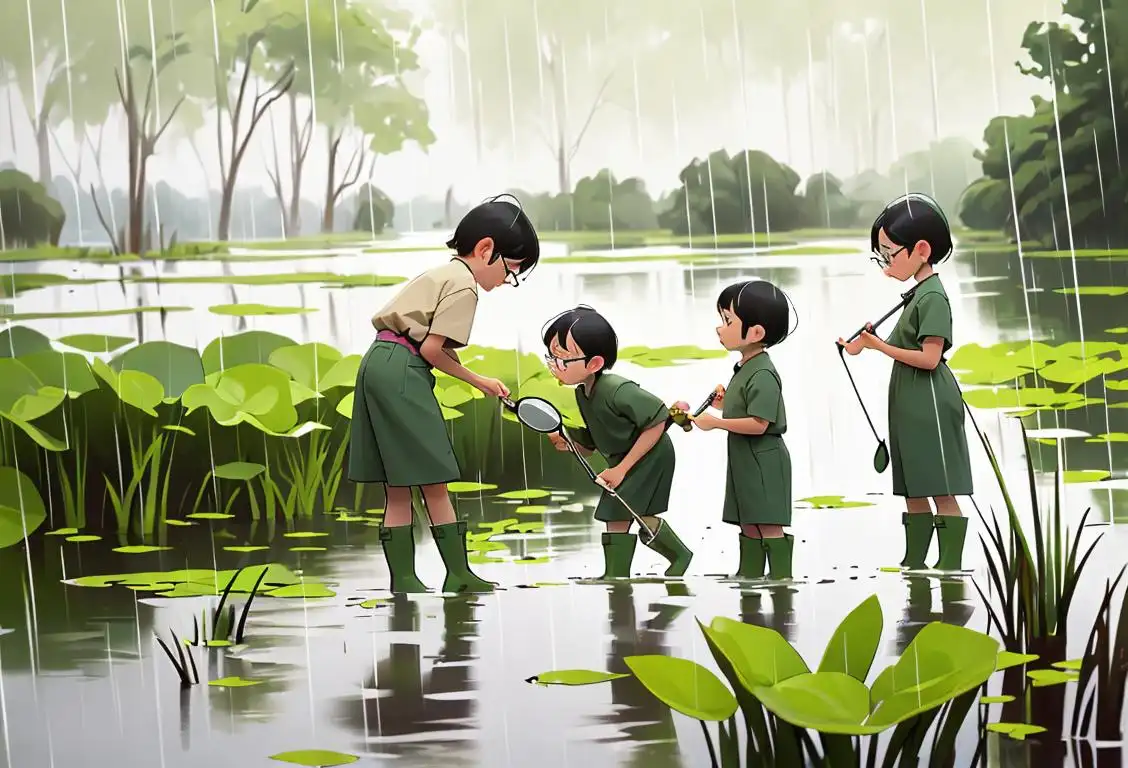National Public Garden Day

Welcome to WhatNationalDayIsIt.com, where we dive into the exciting world of national days! Today, we're celebrating National Public Garden Day, a day dedicated to the beauty and tranquility of these green oases. So, put on your gardening gloves and get ready to explore the wonderful world of public gardens!
When is Public Garden Day?
It's national public garden day on the 11th May.
The Story Behind National Public Garden Day
Every year on the second Friday of May, we honor National Public Garden Day. This special day was established to raise awareness about the importance of public gardens and their role in promoting environmental stewardship and education.
Public gardens are like little slices of paradise, showcasing nature's magnificent creations. They are where vibrant flowers bloom, ancient trees whisper stories of the past, and bustling wildlife finds refuge. These magical spaces offer a serene escape from the hustle and bustle of daily life.
Whether you're a plant enthusiast, a nature lover, or simply seeking some peace and tranquility, visiting a public garden is an excellent way to connect with the natural world. From botanical gardens to community green spaces, these gardens are open to the public and offer a wide array of horticultural delights.
The Impact of Public Gardens
Public gardens play a crucial role in fostering environmental awareness and conservation. They provide an opportunity for people of all ages to develop a deeper appreciation for plants, flowers, and the entire ecosystem. These gardens often host educational programs, workshops, and events that highlight the importance of sustainable practices and environmental stewardship.
What's more, public gardens serve as living laboratories where scientists and researchers can study plants, cultivate rare species, and preserve biodiversity. They contribute to plant conservation efforts and help safeguard endangered species from extinction.
Public gardens also have a significant positive impact on mental and physical well-being. Stepping into a garden allows you to leave behind the stresses of the world and immerse yourself in a peaceful and inspiring atmosphere. They provide a space for relaxation and reflection, promoting mindfulness and overall positive mental health.
Did You Know?
Did you know that the oldest public garden in the United States is the United States Botanic Garden? Established in 1820, this enchanting garden in Washington, D.C., has been captivating visitors with its diverse collection of plants for nearly two centuries!
History behind the term 'Public Garden'
1634
The birth of the concept
In the year 1634, the concept of public gardens first emerged. It was during this time that the idea of setting aside land specifically for public use and enjoyment started to take root. This marked a shift from private gardens, which were typically only accessible to the wealthy and privileged.
13th century
Emergence of ornamental gardens
During the 13th century, ornamental gardens became popular in Europe. These gardens were primarily owned by wealthy individuals and were designed to showcase their status and wealth. They were often adorned with statues, fountains, and carefully manicured plants.
1700s
Emergence of Enclosed Public Spaces
During the 1700s, the concept of public gardens began to emerge. These were enclosed spaces where people could gather, relax, and enjoy nature. The idea was inspired by the formal gardens of European royalty, which were known for their meticulously designed landscapes. Public gardens provided a much-needed escape from the crowded and polluted cities, offering a place for people to reconnect with nature and find solace amidst the urban chaos.
1800s
Rise of Public Parks
In the 1800s, public gardens evolved into larger-scale public parks. The idea of public parks gained momentum during the Industrial Revolution, as urbanization and rapid technological advancements created a necessity for accessible green spaces. Visionaries like Frederick Law Olmsted, the landscape architect behind Central Park in New York City, championed the idea that public parks were essential for the physical and mental well-being of city dwellers. These parks became a symbol of civic pride and were designed to accommodate various recreational activities, from strolling paths and picnic areas to sports fields and cultural amenities.
1670
The rise of botanical gardens
By 1670, botanical gardens began to flourish. These gardens served as a haven for the cultivation and study of various plant species. They played a crucial role in the advancement of botany and plant taxonomy. People flocked to these gardens to learn about different plants and their medicinal properties, ultimately contributing to the dissemination of knowledge and the development of horticultural practices.
16th century
Renaissance gardens and public access
In the 16th century, Renaissance gardens emerged, inspired by the revival of classical art and architecture. These gardens were characterized by their symmetry, geometric designs, and the incorporation of elements such as grottoes and labyrinths. Some Renaissance gardens began to open their doors to the public, allowing people to appreciate the beauty within.
18th century
Public pleasure gardens
During the 18th century, public pleasure gardens became popular in England. These gardens were open to all and provided a space for people to socialize, stroll, and enjoy various forms of entertainment. They often featured music performances, fireworks displays, and even hot air balloon rides.
1900s
Public Gardens for Education and Conservation
During the 1900s, public gardens took on additional roles beyond recreational spaces. Many public gardens started focusing on education, scientific research, and conservation efforts. These gardens became living classrooms, offering visitors an opportunity to learn about plants, horticulture, and environmental sustainability. They played a vital role in preserving endangered plant species and acted as centers for botanical research and plant conservation. Public gardens became increasingly interactive, engaging visitors with interpretive exhibits, guided tours, and programs that highlighted the importance of biodiversity and ecosystem preservation.
1840
The creation of urban parks
In 1840, the establishment of urban parks became increasingly popular. These parks aimed to provide recreational spaces for urban dwellers, offering a respite from the congestion and pollution of cities. The creation of these public gardens transformed the landscape of cities, making them greener and more accessible to people from all walks of life.
19th century
Evolution of public parks and gardens
In the 19th century, the concept of public parks and gardens began to take shape. Influenced by the urbanization and industrialization of cities, public spaces were deemed necessary for the health and well-being of the growing population. These parks and gardens aimed to provide a refuge from the bustling cityscape and allowed people to connect with nature.
1860
The birth of public gardens as cultural institutions
During the mid-19th century, public gardens started to gain recognition as cultural institutions. Not only were they valued for their aesthetic appeal, but they also became important venues for social gatherings, concerts, and art exhibitions. These gardens became symbols of civic pride and showcased the harmonious fusion of nature and art, contributing to the cultural identity of cities.
Present Day
Modern Public Gardens as Urban Oases
In the present day, public gardens continue to serve as urban oases and essential cultural institutions. They offer respite from the fast-paced urban lifestyle and provide a connection to nature in the midst of concrete jungles. Modern public gardens often integrate innovative design elements, sustainable practices, and technological advancements to create immersive and memorable experiences for visitors. They host a wide range of community events, art exhibitions, and educational programs that promote environmental stewardship and foster a sense of community. Public gardens have become iconic landmarks, enriching the cultural fabric of cities and preserving the invaluable relationship between humans and the natural world.
20th century
Modern public gardens
In the 20th century, public gardens evolved to become spaces for education, conservation, and recreation. Many public gardens started focusing on botanical collections, showcasing a wide variety of plant species from around the world. These gardens also became essential for research and conservation efforts to protect endangered plants.
1891
The opening of the Boston Public Garden
In 1891, the iconic Boston Public Garden opened its gates to the public. It was the first public botanical garden in the United States and quickly became a beloved landmark. The design of the garden, with its picturesque landscape, meandering paths, and beautiful sculptures, inspired the creation of many other public gardens worldwide.
Did you know?
Did you know that the oldest public garden in the United States is the United States Botanic Garden?Tagged
awareness nature education conservationFirst identified
8th May 2015Most mentioned on
11th May 2018Total mentions
54Other days
Public Garden Day
Wetlands Day
Bat Appreciation Day
Endangered Species Day
Hen Harrier Day
Fish Migration Day
American Eagle Day
Penguin Day
Tiger Day
Wombat Day








